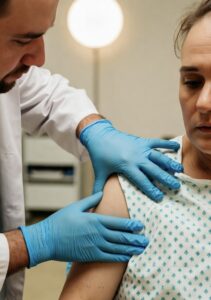Interprofessional care
- The current guidelines focus on
- Assessing the severity of the disease at diagnosis and initial treatment and then
- Monitoring periodically to control the disease
- Intermittent and persistent asthma
- Avoid triggers of acute attacks
- Pre-medicate before exercising
- Short-term (rescue or reliever) medication
- Long-term or controller medication
- Acute asthma exacerbations
- Respiratory distress
- Treatment depends upon severity and response to therapy
- Classified as mild, moderate, severe, or life-threatening
- Management focuses on correcting hypoxemia and improving ventilation
- O2 given via nasal cannula or mask to achieve a PaO2 of at least 60 mm Hg or O2 saturation greater than 90%
- Continuous oxygen monitoring with pulse oximetry
- Bronchodilator treatment
- Short-acting β2-adrenergic agonists (SABAs)
- Assessment during acute exacerbation
- Respiratory and heart rate
- Use of accessory muscles
- Percussion and auscultation of lungs
- PEFR to monitor airflow obstruction
- ABGs
- Pulse oximetry
- Severe and life-threatening exacerbations
- “Silent chest”
- Severely diminished breath sounds
- Absence of wheeze after patient has been wheezing
- Patient is obviously struggling
- Life-threatening situation
- Requires ED and possible ICU
- IV magnesium sulfate
- 100% oxygen
- Hourly or continuous nebulized SABA
- IV corticosteroids
- “Silent chest”
- Bronchial thermoplasty
- Catheter applies heat to reduce muscle mass in the bronchial wall
- Reverses accumulation of excessive tissue that causes narrowing of airway




